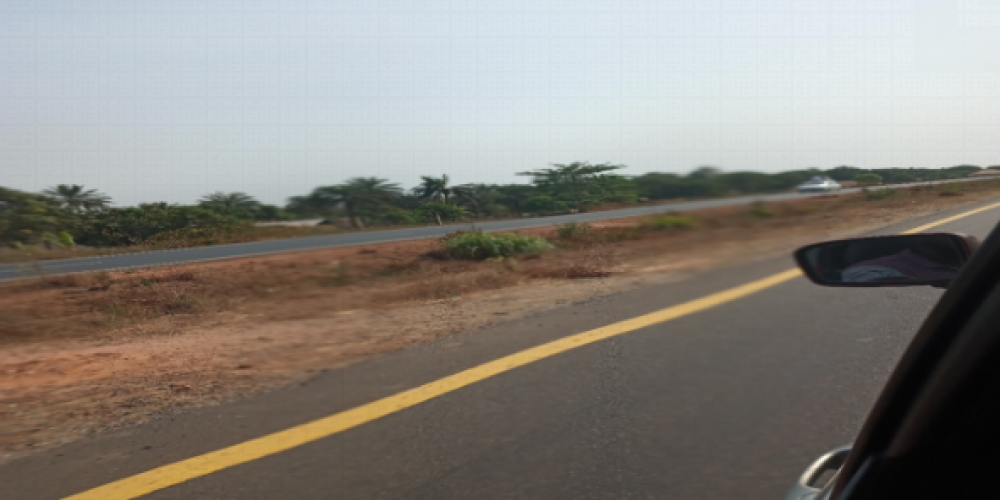That Wellington-Masiaka Highway!
By Jensen Brian Abass Cummings
Infrastructural development is often hailed as the backbone of economic growth, and in Sierra Leone, few projects have made as significant an impact in recent years as the Wellington-Waterloo-Masiaka Toll Road. Commissioned to ease traffic congestion, improve connectivity, and enhance economic activities, this modern highway has been a game-changer. However, despite its numerous benefits, one question continues to linger in the minds of many Sierra Leoneans: Why has the middle path of the road been left unused for years, overgrown with grass and weeds, with no clear purpose or action taken?
The Road That Came at the Right Time
Before the toll road’s construction, traveling from Freetown to Masiaka was a daunting task. Poor road conditions, constant traffic jams, and long travel hours hampered not only individual commuters but also the transportation of goods and services. The economic cost was high, with increased fuel consumption, vehicle maintenance costs, and wasted man-hours.
The opening of the Wellington-Waterloo-Masiaka Toll Road revolutionized this landscape. Travel time was cut drastically, vehicle movement became smoother, and access to the provinces and beyond improved significantly. The road has undoubtedly enhanced trade, boosted tourism potential, and contributed to national development by providing safer and more reliable transportation.
The Agreement and Key Stakeholders
The construction of the toll road was formalized under a Public-Private Partnership (PPP) agreement signed in 2015 between the Government of Sierra Leone and Sinohydro Corporation Limited, a leading Chinese construction firm. The project followed a Build-Operate-Transfer (BOT) model, wherein Sinohydro financed, constructed, and operates the road, with a concession period of approximately 25 to 27 years. During this time, Sinohydro is responsible for toll collections to recoup its investment, after which ownership and management of the road will revert to the government.
This arrangement allowed the government to embark on a critical infrastructure project without incurring immediate heavy financial burdens, while positioning Sierra Leone to benefit from improved road networks and associated economic advantages.
The Lingering Concern: An Unused Middle Path
Despite the road’s success, one perplexing issue stands out—the idle middle path stretching along most parts of the road, particularly from Waterloo to Masiaka. Instead of being utilized, this strip has been left unattended, overgrown with grass and weeds. In some sections closer to Masiaka, attempts were made to plant flowers and trees, but the effort appears half-hearted and has not yielded the desired outcome. From Waterloo onwards, it lies bare, raising more questions than answers.
Why has this space remained wasted for years? Was it initially intended for something that has not materialized?
Possible Explanations
Several theories abound:
- Lack of Agreement: Was there no concrete plan or agreement during construction regarding the use of this middle path?
- Future Expansion Plan: Was the road designed with future expansion to six lanes in mind, but no immediate funding or political will to execute it?
- Beautification Plan Failed: Was the middle strip meant to be developed into a landscaped greenbelt, but maintenance and follow-up failed?
Unfortunately, no clear public communication has been provided by the Ministry of Works or Sinohydro Corporation addressing the purpose or neglect of this space. This silence fuels public speculation and raises concerns about transparency and long-term planning.
Suggestions and The Way Forward
Given the strategic importance of the Wellington-Masiaka Toll Road, the underutilization of its middle path should not continue unchecked. Here are some practical recommendations:
- Public Clarification and Policy Transparency
The Ministry of Works and Sinohydro must issue a formal statement explaining the purpose of the middle strip and whether future plans exist for its use. Transparent communication is crucial to address public curiosity and suspicion.
- Consider Immediate Utilization
If the original design included plans to expand the road to six lanes, it is time to revisit and possibly implement this plan, especially as traffic volume increases. Expanding the road now could preempt future congestion challenges.
- Beautification and Environmental Responsibility
If beautification was the aim, the government, through local councils and corporate social responsibility (CSR) partnerships, should embark on a sustainable landscaping project. Drought-resistant plants, regular maintenance, and proper irrigation systems can transform the middle strip into a green, environmentally friendly belt.
- Commercial and Renewable Energy Potential
Another innovative idea is to explore commercial or renewable energy uses. For example, installing solar panels along the middle strip could generate power for street lighting and toll booths, contributing to Sierra Leone’s green energy targets.
- Community Involvement
Engaging local communities and businesses that benefit from the toll road can foster ownership and maintenance efforts. Programs could be introduced encouraging tree-planting days, road clean-up drives, and CSR funding from companies utilizing the road.
Unlocking Full Potential
The Wellington-Waterloo-Masiaka Toll Road is a clear symbol of Sierra Leone’s commitment to infrastructural growth and economic progress. Yet, the underutilized middle path remains a blemish on an otherwise successful project. The time has come for all stakeholders—government, Sinohydro, and local communities—to collaborate and ensure this space is put to productive use, reflecting the original vision of progress and development.
Sierra Leone deserves not only good roads but complete and thoughtfully utilized infrastructure. Let’s make every meter count.





